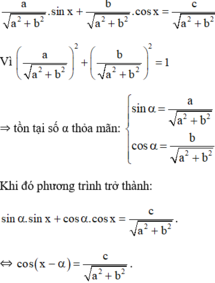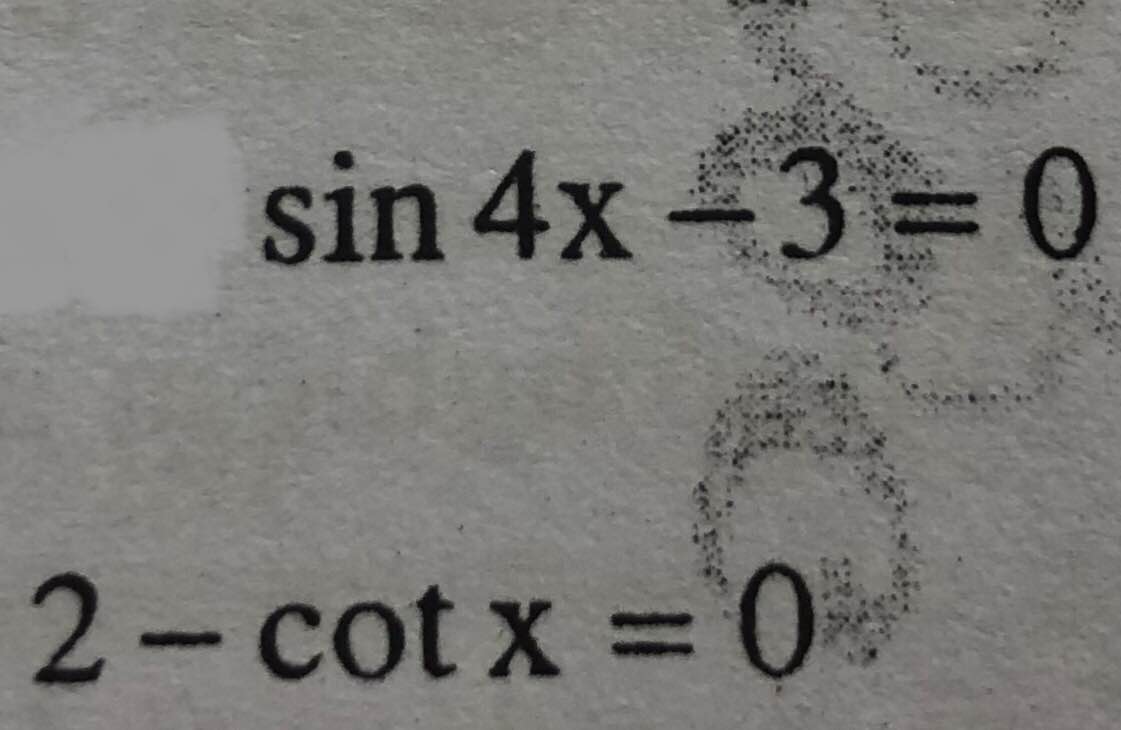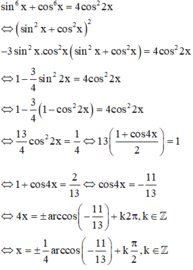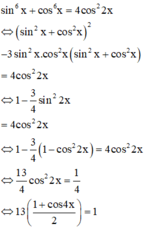
Hãy nhập câu hỏi của bạn vào đây, nếu là tài khoản VIP, bạn sẽ được ưu tiên trả lời.


a) Cách giải các phương trình lượng giác cơ bản:
+ Phương trình sin x = a.
Nếu |a| > 1 ⇒ phương trình vô nghiệm.
Nếu |a| ≤ 1 ⇒ tìm một cung α sao cho sin α = a.
Khi đó phương trình trở thành sin x = sin α
⇒ Phương trình có nghiệm: 
+ Phương trình cos x = a.
Nếu |a| > 1 ⇒ phương trình vô nghiệm.
Nếu |a| ≤ 1 ⇒ tìm một cung α sao cho cos α = a.
Khi đó phương trình trở thành cos x = cos α.
⇒ Phương trình có nghiệm: x = ±α + k2π (k ∈ Z).
+ Phương trình tan x = a.
Tìm một cung α sao cho tan α = a.
Khi đó phương trình trở thành tan x = tan α.
⇒ Phương trình có nghiệm x = α + kπ (k ∈ Z).
+ Phương trình cot x = a
Tìm một cung α sao cho cot α = a.
Khi đó phương trình trở thành cot x = cot α.
⇒ Phương trình có nghiệm x = α + kπ (k ∈ Z).
b) Cách giải phương trình a.sin x + b.cos x = c.
+ Nếu a = 0 hoặc b = 0 ⇒ Phương trình lượng giác cơ bản .
+ a ≠ 0 và b ≠ 0. Chia cả hai vế của phương trình cho  ta được:
ta được:

Ta giải phương trình trên như phương trình lượng giác cơ bản.

\(sinx=\dfrac{2tan\dfrac{x}{2}}{tan^2\dfrac{x}{2}+1}\)
\(cosx=\dfrac{1-tan^2\dfrac{x}{2}}{1+tan^2\dfrac{x}{2}}\)
Đặt \(t=tan\dfrac{x}{2}\)
Khi đó pt: \(\Rightarrow a\cdot\dfrac{2t}{t^2+1}+b\cdot\dfrac{1-t^2}{1+t^2}=c\)
\(\Rightarrow2t\cdot a+\left(1-t^2\right)\cdot b=\left(1+t^2\right)\cdot c\)

\(a,f'\left(x\right)=3x^2-6x\\ f'\left(x\right)\le0\Leftrightarrow3x^2-6x\le0\\ \Leftrightarrow3x\left(x-2\right)\le0\Leftrightarrow0\le x\le2\)
Lời giải:
a. $f'(x)\leq 0$
$\Leftrightarrow 3x^2-6x\leq 0$
$\Leftrightarrow x(x-2)\leq 0$
$\Leftrightarrow 0\leq x\leq 2$
b.
$f'(x)=x^2-3x+2=0$
$\Leftrightarrow 3x^2-6x=x^2-3x+2=0$
$\Leftrightarrow 3x(x-2)=(x-1)(x-2)=0$
$\Leftrightarrow x-2=0$
$\Leftrightarrow x=2$
c.
$g(x)=f(1-2x)+x^2-x+2022$
$g'(x)=(1-2x)'f(1-2x)'_{1-2x}+2x-1$
$=-2[3(1-2x)^2-6(1-2x)]+2x-1$
$=-24x^2+2x+5$
$g'(x)\geq 0$
$\Leftrightarrow -24x^2+2x+5\geq 0$
$\Leftrightarrow (5-12x)(2x-1)\geq 0$
$\Leftrightarrow \frac{-5}{12}\leq x\leq \frac{1}{2}$

ĐKXĐ: \(\left\{{}\begin{matrix}cosx\ne0\\cos2x\ne0\end{matrix}\right.\) \(\Leftrightarrow\left\{{}\begin{matrix}x\ne\dfrac{\pi}{2}+k\pi\\x\ne\dfrac{\pi}{4}+\dfrac{k\pi}{2}\end{matrix}\right.\)
\(\dfrac{3sin2x}{cos2x}-3tanx-\dfrac{5}{2}=0\)
\(\Leftrightarrow\dfrac{6sinx.cosx}{cos^2x-sin^2x}-3tanx-\dfrac{5}{2}=0\)
\(\Rightarrow\dfrac{6tanx}{1-tan^2x}-3tanx-\dfrac{5}{2}=0\)
\(\Rightarrow6tan^3x+5tan^2x+6tanx-5=0\)
\(\Leftrightarrow\left(2tanx-1\right)\left(3tan^2x+4tanx+5\right)=0\)
\(\Leftrightarrow tanx=\dfrac{1}{2}\)
\(\Leftrightarrow x=arctan\left(\dfrac{1}{2}\right)+k\pi\)

Pt ⇔\(\dfrac{1}{sinx.cosx}=\dfrac{1}{2sin\left(x+\dfrac{\pi}{3}\right)}\)
⇔ sinx.cosx = 2sin\(\left(x+\dfrac{\pi}{3}\right)\)
⇔ \(\dfrac{1}{2}\)sin2x = 2sin\(\left(x+\dfrac{\pi}{3}\right)\)
⇔ sin2x = 4sin\(\left(x+\dfrac{\pi}{3}\right)\)















15cos2x-11=0
⇔ cos2x=\(\dfrac{11}{15}\)
\(\Leftrightarrow\left[{}\begin{matrix}2x=15+k2\pi\\2x=-15+k2\pi\end{matrix}\right.\Leftrightarrow\left[{}\begin{matrix}x=\dfrac{15}{2}+k\pi\\x=\dfrac{-15}{2}+k\pi\end{matrix}\right.\)
a.
\(15cos2x-11=0\)
\(\Leftrightarrow cos2x=\dfrac{11}{15}\)
\(\Leftrightarrow2x=\pm arccos\left(\dfrac{11}{15}\right)+k2\pi\)
\(\Leftrightarrow x=\pm\dfrac{1}{2}arccos\left(\dfrac{11}{15}\right)+k\pi\)
b.
\(2tan4x+1=0\)
\(\Leftrightarrow tan4x=-\dfrac{1}{2}\)
\(\Leftrightarrow4x=arctan\left(-\dfrac{1}{4}\right)+k\pi\)
\(\Leftrightarrow x=\dfrac{1}{4}arctan\left(-\dfrac{1}{4}\right)+\dfrac{k\pi}{4}\)